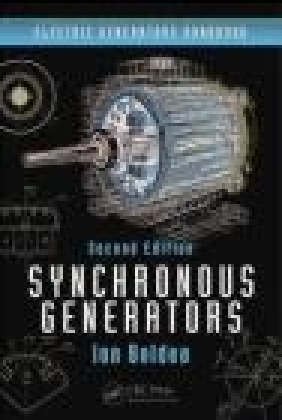Synchronous Generators
Ion Boldea
Synchronous Generators
Ion Boldea
- Producent: Productivity Press Inc
- Rok produkcji: 2015
- ISBN: 9781498723565
- Ilość stron: 498
- Oprawa: Twarda
Niedostępna
Opis: Synchronous Generators - Ion Boldea
Synchronous Generators, the first of two volumes in the Electric Generators Handbook, offers a thorough introduction to electrical energy and electricity generation, including the basic principles of electric generators. The book devotes a chapter to the most representative prime mover models for transients used in active control of various generators. Then, individual chapters explore large- and medium-power synchronous generator topologies, steady state, modeling, transients, control, design, and testing. Numerous case studies, worked-out examples, sample results, and illustrations highlight the concepts. Fully revised and updated to reflect the last decade's worth of progress in the field, this Second Edition adds new sections that: * Discuss high-power wind generators with fewer or no permanent magnets (PMs) * Cover PM-assisted DC-excited salient pole synchronous generators * Present multiphase synchronous machine inductances via the winding function method * Consider the control of autonomous synchronous generators * Examine additional optimization design issues * Illustrate the optimal design of a large wind generator by the Hooke-Jeeves method * Detail the magnetic equivalent circuit population-based optimal design of synchronous generators * Address online identification of synchronous generator parameters * Explain the small-signal injection online technique * Explore line switching (on or off) parameter identification for isolated grids * Describe synthetic back-to-back load testing with inverter supply The promise of renewable, sustainable energy rests on our ability to design innovative power systems that are able to harness energy from a variety of sources. Synchronous Generators, Second Edition supplies state-of-the-art tools necessary to design, validate, and deploy the right power generation technologies to fulfill tomorrow's complex energy needs.Electric Energy and Electric Generators Introduction Major Energy Sources Limitations of Electric Power Generation Electric Power Generation From Electric Generators to Electric Loads Summary References Principles of Electric Generators Three Types of Electric Generators Synchronous Generators Permanent Magnet Synchronous Generators Homopolar Synchronous Generator Induction Generator Wound-Rotor Doubly Fed Induction Generator Parametric Generators Electric Generator Applications High-Power Wind Generators Summary References Prime Movers Introduction Steam Turbines Steam Turbine Modeling Speed Governors for Steam Turbines Gas Turbines Diesel Engines Stirling Engines Hydraulic Turbines Wind Turbines Summary References Large- and Medium-Power Synchronous Generators: Topologies and Steady State Introduction Construction Elements Excitation Magnetic Field Two-Reaction Principle of Synchronous Generators Armature Reaction Field and Synchronous Reactances Equations for Steady State with Balanced Load Phasor Diagram Inclusion of Core Losses in the Steady-State Model Autonomous Operation of Synchronous Generators SG Operation at Power Grid (in Parallel) Unbalanced Load Steady-State Operation Measuring Xd, Xq, Z-, Z0 Phase-to-Phase Short Circuit Synchronous Condenser PM-Assisted DC-Excited Salient Pole Synchronous Generators Multiphase Synchronous Machine Inductances via Winding Function Method Summary References Synchronous Generators: Modeling for Transients Introduction Phase-Variable Model dq Model Per Unit (P.U.) dq Model Steady State via the dq Model General Equivalent Circuits Magnetic Saturation Inclusion in the dq Model Operational Parameters Standstill Time-Domain Response Provoked Transients Standstill Frequency Response Simplified Models for Power System Studies Mechanical Transients Small Disturbance Electromechanical Transients Large Disturbance Transients Modeling Finite-Element SG Modeling SG Transient Modeling for Control Design Summary References Control of Synchronous Generators in Power Systems Introduction Speed Governing Basics Time Response of Speed Governors Automatic Generation Control Time Response of Speed (Frequency) and Power Angle Voltage and Reactive Power Control Basics Automatic Voltage Regulation Concept Exciters Exciter's Modeling Basic AVRs Underexcitation Voltage Power System Stabilizers Coordinated AVR-PSS and Speed Governor Control FACTS-Added Control of SG Subsynchronous Oscillations Subsynchronous Resonance Note on Autonomous Synchronous Generators' Control Summary References Design of Synchronous Generators Introduction Specifying Synchronous Generators for Power Systems Output Power Coefficient and Basic Stator Geometry Number of Stator Slots Design of Stator Winding Design of Stator Core Salient: Pole Rotor Design Damper Cage Design Design of Cylindrical Rotors Open-Circuit Saturation Curve On-Load Excitation mmf F1n Inductances and Resistances Excitation Winding Inductances Damper Winding Parameters Solid Rotor Parameters SG Transient Parameters and Time Constants Electromagnetic Field Time Harmonics Slot Ripple Time Harmonics Losses and Efficiency Exciter Design Issues Optimization Design Issues Generator/Motor Issues Summary References Testing of Synchronous Generators Acceptance Testing Testing for Performance (Saturation Curves, Segregated Losses, and Efficiency) Excitation Current under Load and Voltage Regulation Need for Determining Electrical Parameters Per Unit Values Tests for Parameters under Steady State Tests to Estimate the Subtransient and Transient Parameters Transient and Subtransient Parameters from d and q Axis Flux Decay Test at Standstill Subtransient Reactances from Standstill Single-Frequency AC Tests Standstill Frequency Response Tests Online Identification of SG Parameters Summary References
Szczegóły: Synchronous Generators - Ion Boldea
Tytuł: Synchronous Generators
Autor: Ion Boldea
Producent: Productivity Press Inc
ISBN: 9781498723565
Rok produkcji: 2015
Ilość stron: 498
Oprawa: Twarda
Waga: 1.15 kg



























